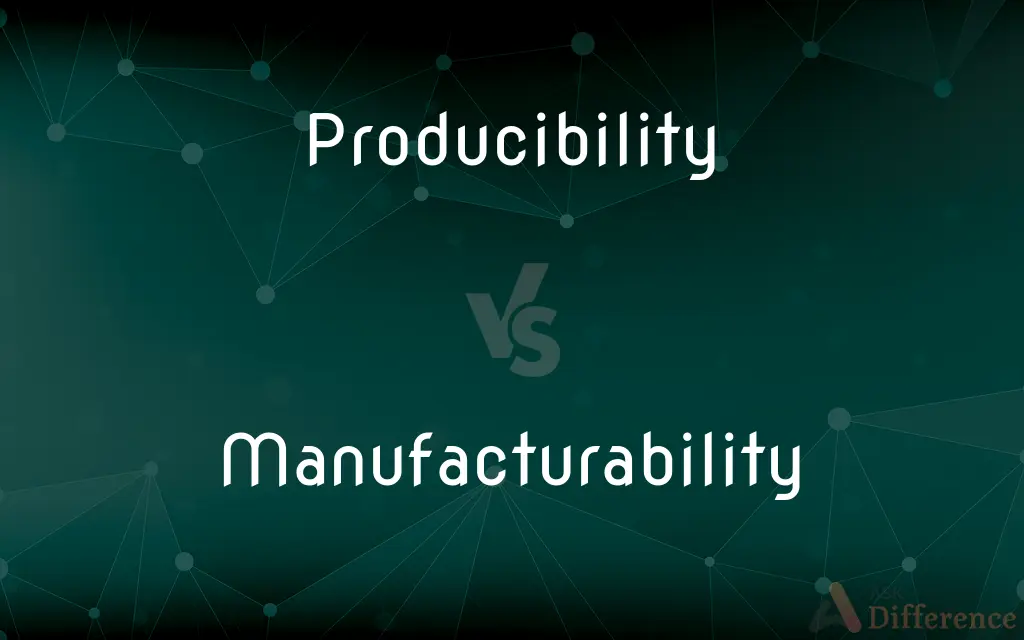Producibility vs. Manufacturability — What's the Difference?
By Tayyaba Rehman & Urooj Arif — Updated on April 8, 2024
Producibility focuses on the ease of making a product, whereas manufacturability emphasizes the efficiency and cost-effectiveness of mass production.

Difference Between Producibility and Manufacturability
Table of Contents
ADVERTISEMENT
Key Differences
Producibility is concerned with the feasibility of creating a product, taking into account the design's complexity, material selection, and overall ability to be produced. It essentially measures how easily a product can be brought from concept to physical form. Whereas manufacturability looks beyond just the production of a single unit to consider how a product can be efficiently manufactured at scale. It involves considerations of cost, speed, and resource optimization in a production line setting.
While producibility might prioritize the use of advanced materials or innovative processes to achieve a unique product, manufacturability leans towards standardization and simplification to ensure products can be produced cost-effectively in large quantities. Producibility often focuses on overcoming technical challenges in the production process, whereas manufacturability seeks to streamline and economize these processes.
Producibility assessments might lead to adjustments in design to make a product easier to create, even if it's in small volumes. On the other hand, manufacturability assessments could drive changes that reduce costs and improve the efficiency of mass production, potentially at the expense of individual product customization.
In the development phase, producibility plays a crucial role in determining whether a product can be made at all, considering current technology and methods. Manufacturability, meanwhile, becomes critical in the scaling phase, where the focus shifts to how well a product can be replicated within the constraints of time, quality, and budget.
Though both concepts aim to optimize the production process, producibility is more about the product's journey from design to prototype, focusing on achievable manufacturing methods. Manufacturability, in contrast, is concerned with the product’s journey from prototype to market, emphasizing efficient, large-scale production strategies.
ADVERTISEMENT
Comparison Chart
Focus
Ease of bringing a design to production
Efficiency and cost-effectiveness in mass production
Key Considerations
Design complexity, material selection, production capability
Cost reduction, process standardization, production speed
Stage
Early development, from concept to prototype
Scaling phase, from prototype to mass production
Goal
To ensure a product can be made
To ensure a product can be made efficiently and economically at large scale
Outcome
Product feasibility and technical viability
Optimized production processes for market competitiveness
Compare with Definitions
Producibility
Measurement of how straightforward the manufacturing process of a product is.
The engineering team improved the product's producibility by simplifying its assembly process.
Manufacturability
A measure of how easily and economically a product can be manufactured at scale.
Adjustments to the design improved the product's manufacturability, reducing costs by 20%.
Producibility
Evaluation of a product's manufacturing feasibility.
The prototype’s producibility was questionable due to its complex internal mechanisms.
Manufacturability
Assessment of a product design for cost-effective and efficient production processes.
Early manufacturability reviews identified potential bottlenecks in the supply chain.
Producibility
The ability to produce a design or product easily and practically.
The producibility of the new gadget was confirmed after several design adjustments.
Manufacturability
The ability to produce large quantities of a product without compromising quality or increasing costs.
The company focused on improving manufacturability to meet the growing market demand.
Producibility
Consideration of the necessary resources, technology, and time to manufacture a product.
Producibility analysis showed that custom parts would significantly delay production time.
Manufacturability
The characteristic of a product's design that allows for its efficient mass production.
The device's manufacturability was enhanced by standardizing components.
Producibility
The degree to which a product design supports efficient production.
High producibility was achieved by selecting materials that are readily available and easy to work with.
Manufacturability
Optimization of production processes for scalability and economic efficiency.
Streamlining the assembly line significantly boosted the product’s manufacturability.
Producibility
The quality or state of being producible.
Manufacturability
The condition of being manufacturable
Producibility
The measure of the relative ease of manufacturing.
Producibility
The quality or state of being producible.
Common Curiosities
Why is manufacturability important in mass production?
Manufacturability is crucial for mass production as it ensures that products can be produced efficiently and economically, maintaining quality while minimizing costs.
How can manufacturability reduce production costs?
Manufacturability reduces production costs by optimizing design and processes for mass production, focusing on standardization, simplification, and supply chain efficiency.
How do producibility and manufacturability relate to product development?
Both concepts are integral to product development; producibility ensures a product can be made, while manufacturability ensures it can be made efficiently at scale.
How do engineers assess producibility?
Engineers assess producibility by evaluating design complexity, material choices, and the required manufacturing technologies and processes.
Is producibility more relevant to custom products?
Yes, producibility is particularly relevant to custom or niche products where the focus is on feasibility and small-scale production.
What is producibility?
Producibility refers to how easily and practically a product can be made from its design, focusing on feasibility and the production process's technical aspects.
What is manufacturability?
Manufacturability assesses a product's design for efficient and economical mass production, emphasizing cost reduction and process optimization.
How does producibility impact product design?
Producibility impacts product design by necessitating adjustments to ensure the product can be manufactured using available resources and technologies.
Can a product be producible but not manufacturable?
Yes, a product can be producible, meaning it can be made on a small scale, but not manufacturable if it cannot be efficiently mass-produced due to cost or complexity.
What role do materials play in producibility?
Materials play a significant role in producibility by affecting the ease of manufacturing, availability, and the product's final functionality and aesthetics.
Can improvements in producibility lead to better manufacturability?
Yes, improvements made for producibility, such as simplifying a design or choosing more accessible materials, can also enhance manufacturability.
Does manufacturability compromise product quality?
Not necessarily; manufacturability aims to maintain quality while making production more efficient and cost-effective.
How does technology impact producibility and manufacturability?
Technology impacts both by enabling more complex designs to be producible and by providing advanced manufacturing methods that improve manufacturability.
Why is early consideration of manufacturability important in product design?
Early consideration of manufacturability is important to ensure that the product can be produced efficiently at scale, helping to avoid costly redesigns later.
What factors influence manufacturability?
Factors influencing manufacturability include design simplicity, material selection, production methods, and the efficiency of the assembly process.
Share Your Discovery

Previous Comparison
Hot vs. Heavy
Next Comparison
Atlantis vs. AtlasAuthor Spotlight
Written by
Tayyaba RehmanTayyaba Rehman is a distinguished writer, currently serving as a primary contributor to askdifference.com. As a researcher in semantics and etymology, Tayyaba's passion for the complexity of languages and their distinctions has found a perfect home on the platform. Tayyaba delves into the intricacies of language, distinguishing between commonly confused words and phrases, thereby providing clarity for readers worldwide.
Co-written by
Urooj ArifUrooj is a skilled content writer at Ask Difference, known for her exceptional ability to simplify complex topics into engaging and informative content. With a passion for research and a flair for clear, concise writing, she consistently delivers articles that resonate with our diverse audience.















































